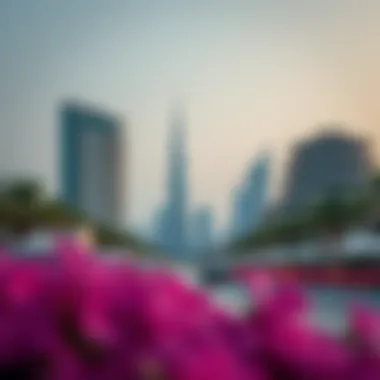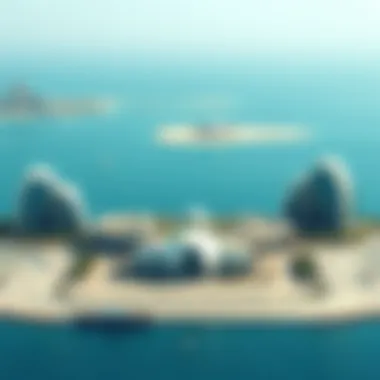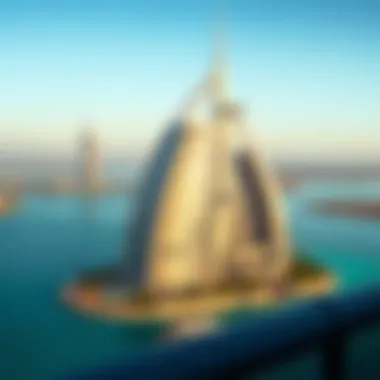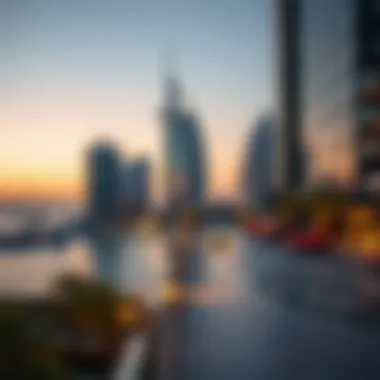The Geographic Importance of Dubai's Islands


Intro
Dubai islands, known for their extravagant designs and vibrant communities, have become a focal point in real estate discussions. Their geographic significance extends beyond their beautiful landscapes. These islands play a crucial role in the urban fabric of Dubai, acting as catalysts for economic growth, tourism, and real estate investment. Understanding their positioning helps investors and homeowners alike navigate the complexities of this ever-evolving market.
Dubai’s island developments, including the Palm Jumeirah and the World Islands, embody a blend of innovation and ambition. These are not just feats of engineering; they represent a strategic vision to enhance the city’s global appeal. The importance of their location cannot be overstated—they sit at a nexus of trade routes and are easily accessible from major international airports, making them a natural draw for tourists and investors.
As we delve deeper into the significant aspects surrounding these islands, key insights regarding the property market, investment opportunities, and economic implications will emerge. Let's embark on this exploration to understand better what makes Dubai's islands a beacon for those eyeing real estate ventures here.
Prologue to Dubai Islands
The islands of Dubai represent more than just a striking view or lucrative real estate opportunities; they symbolize the ongoing interplay of nature, urbanization, and advanced planning. In a region where the desert meets the sea, the strategic development of these coastal gems has carved out a niche that attracts investors and homeowners alike. The multifaceted nature of the Dubai Islands offers elements of grandeur and investment potential that benefit both local and international stakeholders.
Overview of Dubai's Coastal Landscape
Dubai's coastal landscape is a marvel of engineering and vision. With its pristine beaches and rich marine ecosystems, it provides a natural allure that draws millions annually. The coastline stretches along the Persian Gulf, setting the stage for the creation of several man-made and natural islands, each with unique characteristics.
- Palm Jumeirah is the most lauded, designed in the shape of a palm tree, it extends far into the gulf, showcasing luxury villas and hotels.
- The World Islands, another innovative project, creates the semblance of a world map, bringing together various nations' cultures into one locality.
- Bluewaters Island, housing the iconic Ain Dubai, integrates leisure and lifestyle, attracting both residents and tourists.
The diverse coastal features position Dubai as a significant hub for maritime activities, tourism, and luxury living. Furthermore, Dubai’s commitment to preserving these landscapes highlights its understanding of ecological importance and aesthetics.
Historical Context of Island Development
Understanding the history behind Dubai’s islands offers a crucial perspective on their significance today. The evolution is a testament to human ingenuity and ambition. Initially, Dubai was primarily a fishing and trading port, with growth spurred by the discovery of oil in the 20th century. This newfound wealth provided the impetus for massive development projects, including the creation of islands.
In the late 1990s, projects like Palm Jumeirah began taking shape, symbolizing not just luxury but the aspiration of transforming Dubai into a cosmopolitan city. This transformation continued to gain momentum into the 21st century, with several islands emerging as major tourist destinations alongside their residential functions.
Dubai’s leadership has carefully steered these developments, emphasizing both aesthetics and functionality. The islands are not mere tourist attractions; they serve as locales for cultural events, entertainment, and residential spaces reflecting Dubai’s rapid growth. This historical context is essential for any investor or analyst looking to navigate the intricacies of Dubai's real estate market.
In summary, the islands of Dubai come from a rich tapestry of natural beauty and ambitious development. They hold substantial economic and cultural significance, which will further unfold in subsequent sections.
Location Analysis of Dubai Islands
Analyzing the location of Dubai's islands offers a window into their unique advantages and potential. The geographical positioning not only influences tourism and residential trends but also plays a critical role in the economic viability of developments in this region. Understanding how these islands connect with the mainland and surrounding water bodies can highlight the importance of strategic planning in an area known for its rapid growth.
Geographical Coordinates and Features
The geographical coordinates of Dubai islands primarily range between 24° and 25° North latitude and 54° and 56° East longitude. Some of the most notable artificial islands include the Palm Jumeirah, known for its distinctive palm tree shape, and the World Islands, representing a collection of countries. The unique shapes and configurations of Dubai's islands exemplify advanced engineering and planning, showcasing a blend of natural landscapes with human-made creations.
The islands themselves vary in size, topography, and features. For example, Palm Jumeirah spans approximately 560 hectares, making it one of the largest man-made structures visible from space. This substantial size translates into considerable land for development, making it a prime target for investors and homeowners alike. The islands also provide strategic points for marine and air navigation, aligning with Dubai’s vision of becoming a global hub for commerce and tourism.
Relation to Dubai Mainland
The proximity of Dubai islands to the mainland is a double-edged sword; it presents both opportunities and challenges. For starters, the connection to the mainland through major routes enhances accessibility for residents and tourists. The iconic Atlantis resort, located at the tip of Palm Jumeirah, draws visitors not only from within the UAE but also from around the globe due to its location.
However, developers must consider the potential for congestion as the popularity of the islands grows. Infrastructure development, including roads and public transport systems, becomes essential for maintaining a balance between tourist influx and living standards. Future projects may expand existing routes or introduce new transportation modes, further reinforcing the connectivity that is so vital for island life.
Surrounding Water Bodies


The surrounding water bodies play a pivotal role in defining the ecological and economic landscape of the Dubai islands. The Arabian Gulf surrounds these islands, providing both a scenic backdrop and essential resources. The clear waters teem with marine life, enhancing the appeal of waterfront living and recreational activities, such as yachting and water sports.
The presence of vibrant coral reefs and fish populations along certain coastal areas is an attracting factor for eco-tourism ventures. However, this interaction raises environmental considerations that cannot be overlooked. Encouraging sustainable practices while maximizing the economic potential of these ecosystems is a challenge that developers and policymakers face.
As Dubai looks to the future, understanding the geographical significance of its islands will be crucial. Merely developing land without accounting for natural resources and community needs could lead to long-term repercussions.
Accessibility and Transportation
Accessibility and transportation stand as crucial pillars in the discussion of Dubai Islands. The connectivity of these islands shapes not just their attractiveness for potential investors but also their viability for long-term sustainability. As urban development continues to surge, understanding the access routes and transportation frameworks becomes essential for navigating the intricacies of this unique real estate market.
Major Access Routes
The major routes leading to Dubai Islands are designed not only for efficiency but also to facilitate the seamless integration of these islands into the broader urban fabric of Dubai. Key road networks include the Sheikh Zayed Road, which serves as the main artery, allowing swift access from the mainland. Another significant route is the Al Sufouh Road, which connects various parts of the city straight to the shores of Palm Jumeirah.
Additionally, water transport plays a vital role. Water taxis and ferries often shuttle between the islands and the mainland, providing a scenic and efficient alternative to road travel. This blend of travel modes ensures that residents and visitors can navigate effectively, fostering a sense of community activity and engagement.
- Key Connections:
- Sheikh Zayed Road
- Al Sufouh Road
- Water taxis and ferries
In essence, these access routes do more than offer practical transit options. They underscore the strategic planning efforts undertaken to ensure that the Dubai Islands remain as bustling hubs rather than isolated havens.
Impact of Transportation Infrastructure on Property Value
The transportation infrastructure surrounding the Dubai Islands directly influences the property value in these regions. Increases in accessibility generally correlate with rising property prices. For example, areas that have recently seen the expansion of roads or the launch of new ferry services often experience a spike in real estate interest.
Investors are particularly keen to observe new transport initiatives, as they heavily sway buyer confidence. Properties that are a stone's throw away from major access points—like the upcoming connection from the Dubai Metro—tend to command higher prices. Moreover, the convenience factor associated with well-planned transport systems makes properties more desirable to homeowners and expatriates alike.
This dynamic not only reinforces the importance of transportation but also illustrates how strategic planning impacts the economic landscape of Dubai's islands. In the ever-evolving real estate sector, recognizing these trends is essential for investors looking to capitalize on growth opportunities.
"The correlation between transportation infrastructure and property values cannot be overstated; as access improves, wealth potential increases."
Economic Implications of Island Locations
The economic implications of Dubai's island locations are multifaceted, weaving together the threads of tourism, real estate, and investment dynamics. Each island serves not merely as a picturesque getaway but as a strategic hub that can drive significant economic activity and regeneration. This section dives deep into how these factors interplay to shape Dubai's economic landscape and how they may benefit stakeholders from multiple sectors.
Tourism and Hospitality Ventures
Dubai's islands have become synonymous with luxury and leisure, attracting visitors from all over the globe. The result is an economy that thrives on tourism. Establishments like Atlantis, The Palm present a quintessential example of how islands can enhance the hospitality sector. Tourists flock to such venues, seeking unique experiences that blend shopping, dining, and entertainment—all set against the backdrop of stunning sea views.
Moreover, with attractions like the Burj Al Arab near the coast, the islands complement the existing hospitality infrastructure, benefitting from an influx of visitors looking for opulence. This synergy offers a prime opportunity for hotels and resorts to capitalize on a booming market. Beyond the established brands, new players are keen to dive in.
- Local Investments: Residents are seeing the emergence of smaller boutique hotels and eco-friendly resorts, tapping into the growing sustainable tourism trend.
- Job Creation: The hospitality industry generates a plethora of job opportunities, enhancing local livelihoods.
The hospitality sector is not just making waves; it's creating a tidal change in how the economy operates around the islands.
Real Estate Development Trends


In recent years, the islands of Dubai have attracted major real estate investment, showcasing trends that reflect the broader narrative of urban development. Developers are focusing on luxury residential options, leisure resorts, and exclusive commercial spaces. Projects like the Bluewaters Island, which houses the Ain Dubai observation wheel, exemplify innovative design that draws both local and international interests.
Investment in real estate on these islands is primarily driven by:
- High Demand for Luxury Living: As the population grows and expatriates continue to flock to Dubai, the demand for prime residential properties has skyrocketed.
- Mixed-Use Developments: Strategies that blend residential, commercial, and recreational spaces can maximize land use and appeal to various demographics.
- Sustainability Initiatives: Developers face increasing pressure to incorporate eco-friendly practices, balancing profit with environmental responsibility.
Thus, the real estate trend is not merely about bricks and mortar but about curating environments that resonate with a high standard of living.
Investment Opportunities and Challenges
Investing in Dubai's islands can be a mixed bag of opportunities and challenges. On one hand, the allure of profit in a growing market is undeniable. On the other hand, potential investors must navigate a complex landscape that includes regulatory hurdles, market fluctuations, and competitive pressures.
Key points to consider include:
- Regulatory Framework: Understanding local laws and obtaining approvals can be daunting for first-time investors. Hence, engaging local experts proves invaluable.
- Market Uncertainties: External factors, such as global economic conditions, can affect property demand and, subsequently, investment returns.
- Competitive Market: As more stakeholders notice the potential of Dubai islands, the competition intensifies, potentially leading to oversaturation in certain areas.
Despite these hurdles, the islands remain a hotbed for savvy investors who are willing to do their homework. As one knowledgeable investor noted,
"The real key lies in recognizing the right opportunity at the right time. Dubai's islands are evolving, and those who stay informed can reap considerable benefits."
In summary, the economic implications of island locations in Dubai reveal a complex ecosystem fueled by tourism, real estate, and investment. Stakeholders must remain agile and aware of the dynamic landscape to harness the true potential of this remarkable region.
Environmental Considerations
Understanding the environmental considerations surrounding the Dubai Islands is crucial for comprehending their broader significance. The unique coastal ecosystem of Dubai, combined with rapid urban development, poses challenges that require thoughtful approaches to sustainability and conservation. This discussion not only highlights the ecological implications but also underscores the importance of integrating environmental practices into real estate and urban planning decisions on these islands.
Sustainability Practices in Island Development
Sustainability has become a cornerstone of development strategy on the Dubai Islands. Utilizing green technologies and environmentally friendly materials for construction is part of this approach. There's a growing emphasis on renewable energy sources like solar power, making significant strides towards reducing carbon footprints.
Moreover, water conservation is a critical element. Given the region's arid climate, it's essential to implement systems that reuse and recycle water. Strategies like installing high-efficiency irrigation systems for green spaces can help maintain the islands’ natural beauty while minimizing waste.
Building regulations now often include requirements for wildlife corridors and habitat preservation within development plans. For instance, certain areas may be set aside to allow local flora and fauna to thrive, ensuring that the islands remain ecologically diverse. Here are some key aspects of sustainability practices:
- Use of solar panels and wind turbines.
- Innovative water management systems.
- Native plant landscaping to reduce irrigation needs.
- Preservation of existing ecosystems during new developments.
Investors looking to navigate the real estate market in Dubai should keep these sustainability practices in mind. Properties that adhere to eco-friendly principles often experience higher demand and appreciation in value.
Impact on Marine Ecosystems
The nine clusters of islands in Dubai offer stunning vistas, but their construction and maintenance have impacted surrounding marine ecosystems. Coastal developments, if not managed properly, can lead to habitat degradation and changes in local biodiversity. Coral reefs, vital for marine life, are particularly susceptible to changes in water temperature and quality due to development.
Sedimentation caused by construction can smother delicate coral systems, disrupting the natural balance of marine environments. Moreover, increased water traffic and pollution from nearby developments can lead to detrimental effects on fish populations.
To combat these impacts, measures like monitoring water quality and conducting regular biodiversity assessments are vital. This will ensure that the marine ecosystem surrounding the islands remains vibrant. Furthermore, efforts to restore damaged habitats can provide a pathway for rehabilitation.
Investing in eco-restoration projects not only benefits marine life but also bolsters the image of the Dubai Islands as sustainable destinations for travelers, thereby enhancing their attractiveness for tourism and investment alike.


The health of marine ecosystems is a litmus test for the overall environmental sustainability of the Dubai Islands. As the region continues to grow, balancing development with ecological conservation remains a pressing priority for local stakeholders, investors, and planners alike.
Cultural Dimensions and Local Communities
Understanding Cultural Dimensions and Local Communities is vital when spotlighting the Dubai Islands. This area embodies a rich tapestry of cultures, traditions, and modern lifestyles, all evolving in tandem with rapid urban development. The islands do not merely serve as a backdrop for residential and commercial ventures; they are also vibrant hubs fostering diverse communities and cultural exchanges. The interaction between historical legacies and contemporary influences creates a unique space that appeals to both investors and residents.
Cultural Heritage and Modernization
Dubai Islands are testaments to how cultural heritage can blend seamlessly with modernization. These islands proudly showcase architectural styles that reflect the Emirati aesthetic, while also embracing global influences in design and urban planning. This juxtaposition is evident in places like Palm Jumeirah and The World Islands, where traditional Middle Eastern motifs coexist with modern luxury standards.
- Architectural Influence: Grand structures such as the luxurious hotels and upscale residences are also equipped with facilities that tell the story of Dubai's rich past. For instance, Barjieh tower on Al Marjan Island exhibits classical Islamic architecture while being a centerpiece of modern tourism.
- Cultural Events: The islands host numerous cultural festivals and events, such as the Dubai Art Season, which actively promotes local artists and integrates cultural heritage into the contemporary urban narrative. This fosters a sense of belonging among residents and visitors alike.
The balance between respecting traditions and embracing change can yield profound benefits. It can enhance not only the aesthetic appeal of the islands but also the overall community experience, encouraging deeper connections between individuals from various backgrounds.
Community Engagement and Lifestyle
An important element of life on the Dubai Islands is community engagement. Active participation in neighborhood initiatives, social gatherings, and cultural activities fosters a sense of unity. Living in such a vibrant environment encourages residents to create meaningful relationships, reinforcing social bonds that can positively affect property values and local economies.
- Local Markets: For example, Nakheel Mall, located on Palm Jumeirah, serves as a community hub where locals gather for shopping, dining, and entertainment. The mall is more than a commercial space; it acts as a cultural meeting point that offers events like food festivals and community workshops.
- Sustainable Living: Residents are increasingly advocating for sustainability within their communities. Many homeowners engage in initiatives that promote eco-friendly practices, from beach clean-ups to community gardens, enhancing their living areas while preserving the natural beauty surrounding them.
The lifestyle of those inhabiting the Dubai Islands reflects a harmonious blend of tradition and modernity. Whether it’s through shared community spaces or joint cultural events, the islands encourage a lifestyle that values connectivity among residents. This aspect is not only crucial in attracting potential investors, who see value in livable communities but also in enhancing the quality of life for those who call these islands home.
"Cultural diversity serves both as a strength and an identity for Dubai Islands, enabling different communities to thrive together while showcasing their unique attributes."
As we explore the cultural dimensions and communities on the Dubai Islands, it becomes clear that their significance transcends economic benefits. These aspects contribute to shaping environments where cultural vibrancy and community spirit flourish, ultimately making the islands appealing to a diverse array of inhabitants and investors alike.
Future Trends in Dubai Island Development
Understanding the future trends in Dubai island development is crucial for stakeholders looking to tap into the island's potential. The insights provided here will encapsulate the anticipated changes and possibilities that can redefine not just the islands but also the overall landscape of Dubai itself.
Projected Growth Patterns
The projected growth patterns for the islands in Dubai underline a landscape that is not just growing but evolving. With government initiatives aiming to boost its appeal as a global hub, numbers suggest that the region could see a rise in population density. Such changes invite both opportunities and challenges.
- Population Growth: Estimates indicate an influx of people drawn by job opportunities in tourism, real estate, and technology sectors. Analysts posit that the current pace may double the existing population in the coming decade.
- Strategic Developments: The government plans to integrate mixed-use developments, balancing residential, commercial, and recreational spaces. That makes the islands attractive not only for tourists but also for families and businesses seeking long-term venues.
In past endeavors, shifts toward sustainable and innovative projects have so far shown promising returns and will likely continue in the future.
Technological Innovations in Real Estate
With tech rapidly ushering in a new era, real estate development on the islands is no exception. One can expect transformative technologies to adapt the landscape dramatically.
- Smart Housing: As part of a broader digital transformation, smart homes equipped with IoT devices can lead to energy efficiency and enhanced comfort. The aim is to provide residents with greater control over their living environments.
- Augmented Reality Tours: Property developers are employing AR technology to offer virtual tours of properties. This allows potential buyers to visualize their futures in various locations across the islands without even setting foot on them.
These innovations are not just about convenience; they are pivotal to attracting a tech-savvy generation and creating a smarter, more efficient living space. Investments in tech at the island developments can set a benchmark for future real estate dynamics.
Long-term Sustainability Goals
A significant focus on sustainability will play a vital role in shaping the islands' future. As ecological concerns rise globally, these islands are positioned to lead with innovative solutions.
- Renewable Energy Initiatives: The UAE has already made strides towards solar energy. Plans are in motion to further harness renewable resources to sustain island operations, which will be a selling point for eco-conscious investors.
- Sustainable Tourism Practices: Initiatives encouraging eco-friendly tourism will likely be implemented. These may include reducing carbon footprints through better waste management systems and green transportation options, ensuring long-term viability of the islands.
The blend of these elements supports a vision where economic prosperity goes hand in hand with environmental stewardship. A well-planned approach to sustainability will ultimately appeal to both investors and residents looking for a better quality of life.
"The synergy between technological innovations and sustainability will pave the way for a future-ready Dubai, setting an example for island development across the globe.”







